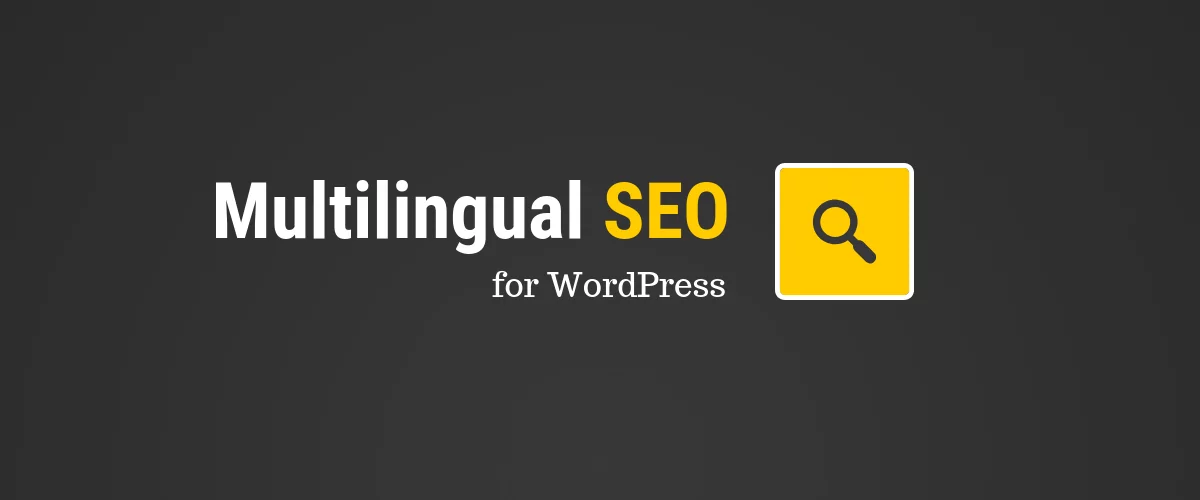
In this post
Search engine optimization is hard enough when you’re only trying to rank in one language. But add a few more languages to the mix? Well, yeah, WordPress multilingual SEO can feel a little overwhelming.
It doesn’t have to, though. Multilingual SEO on WordPress is really just about applying all those same SEO principles and then following some basic guidelines to make sure that each target language has the same chance to benefit from your SEO efforts and rank in Google.
In this tutorial, we’ll cover the best WordPress multilingual SEO principles so that you can have all your site’s translations ranking.
You’ll still need to build some links and do some keyword research, but this guide will make sure Google can index all your content and serve up the right translation to visitors from around the world.
Let’s dive in…
Why Is WordPress Multilingual SEO Important?
We all want our websites to be found on Google. Typically, SEO strategies involve optimizing your content—content that you’ve put together in your native language. But if you want to target audiences in different countries and regions, you need to deliver content that is in their native language.
When you make your site available in many foreign languages, you can benefit from two things:
- Reaching new audiences and a wider target market; and
- Improving your chances of ranking in several languages and in specific regions.
For example, translating your English language content into French makes it possible for users searching in French to find the French version of your website. Ultimately, multilingual search engine optimization is about making it easier for people to find you.
But it’s about more than just providing straight-up translations.
Appealing to the local culture, whether by displaying local currencies, addressing cultural differences, or making references that will be understood and appreciated, will obviously help improve the user experience.
And the better the user experience, the longer users will stay browsing your site. This, in turn, will reduce your bounce rate and signal to Google that you’ve got great content.
Google’s ever-evolving algorithm takes these user behaviors into account, which means translating your content and optimizing for multilingual SEO not only helps visitors who arrive on your site, but will help drive more traffic to your site, too.
WordPress multilingual SEO is fairly straightforward to implement, as long as you know what you’re doing. Start with the actionable steps below.
1. Start with Keyword Research
Obviously, content is a crucial part of your SEO strategy. Without it, you won’t rank in Google!
If you want to provide content in more than one language, you’ll need to translate it for the different countries and regions you want to target. That means either adapting existing content on your site or creating new content.
A solid SEO content strategy starts should always start with keyword research. This means identifying the target keywords for each region and language, along with appropriate search terms.
You’ll need to research your audience to understand the local culture. The keywords that might be relevant for your product or business in your language might be different—even when translated—for your target countries. There may even be colloquial or slang terms that people use, which you’ll want to account for in your multilingual SEO strategy.
It’s a good idea to have native speakers translate or at least check your WordPress multilingual content. This will go a long way to avoiding awkward mistakes and content getting lost in translation.
2. Make Sure Google Can Crawl Each Language
Let’s start at the beginning – you can’t rank your multilingual WordPress site if Google can’t index it.
Services like Google Translate have made it easy to let people dynamically translate your website into any language (kind of like how the Chrome Browser can automatically translate text).
Now, that type of translation is fine if you want to let people who are already on your site browse your content in their own language. But it’s not what you want for WordPress multilingual SEO.
According to Google, “If you prefer to dynamically change content or reroute the user based on language settings, be aware that Google might not find and crawl all your variations.”
If you’re serious about SEO, you need a tool that will help you create static, crawlable versions of your site. That means each language version needs a different URL.
For example, if you have a German translation of your site, it needs to have its own URL structure, like de.example.com or example.com/de.
3. Pick the Right URL Structure For Different Languages
Search engines are pretty flexible with how you structure the URLs of your multilingual site, but Google does have some tips for how to choose the best URL structure.
Let’s start with what you should do. Google recommends choosing from one of these three URL structures:
- Subdirectories for each language – example.com/de/
- Subdomain for each language – de.example.com
- Country-specific domain name – example.de for German visitors and example.com for English visitors
However, Google does not recommend using URL parameters – e.g. example.com?lang=de – because this approach:
- Makes it harder for users to recognize geotargeting from the URL
- Doesn’t let you use the geotargeting functionality in Google Search Console (more on that later).
The TranslatePress plugin uses subdirectories (aka sub-folders) for each language, which is one of Google’s recommended approaches.
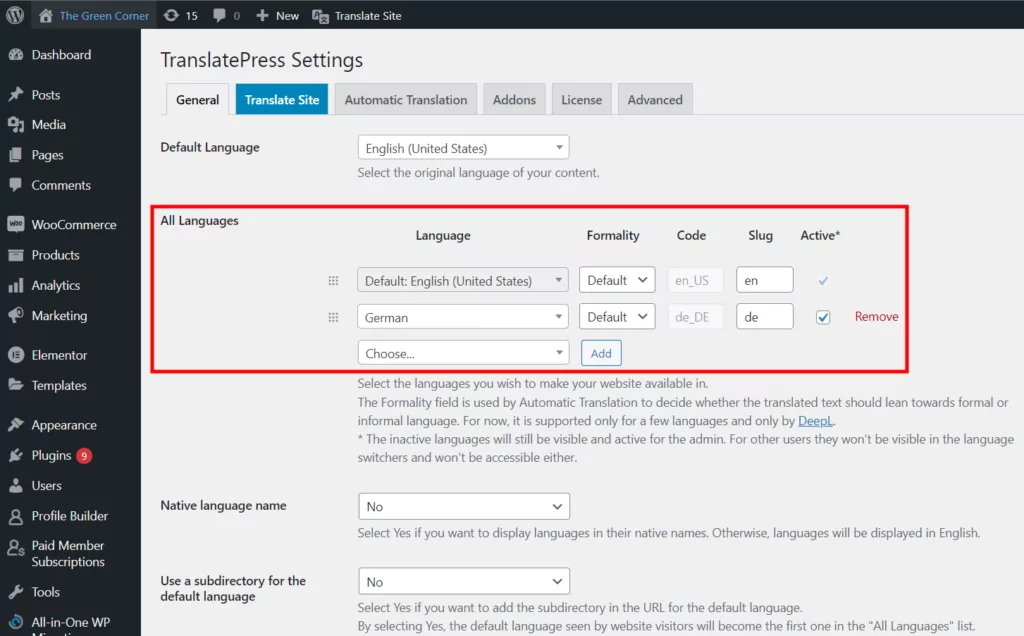
Don’t Forget About WordPress Slugs, Either
Beyond the overall URL structure, there’s also another important consideration for WordPress multilingual SEO:
The URL slug for individual pieces of content.
Some WordPress translation plugins won’t let you translate the URL slug for individual posts or pages, which creates this awkward situation where you have:
- example.com/hello-world
- example.com/de/hello-world
Instead of:
- example.com/hello-world
- example.com/de/hallo-welt
Why does that matter? Well, beyond just being more user-friendly, a good general SEO strategy is to use your primary keywords in your URL slug.
So if you can’t translate the URL slug for each piece of content, you lose the ability to include your primary keyword in other languages, which hurts your translations’ SEO optimization.
Using TranslatePress’ SEO Pack add-on you’ll be able to fully translate the URL slug in each language (directly from the front-end).
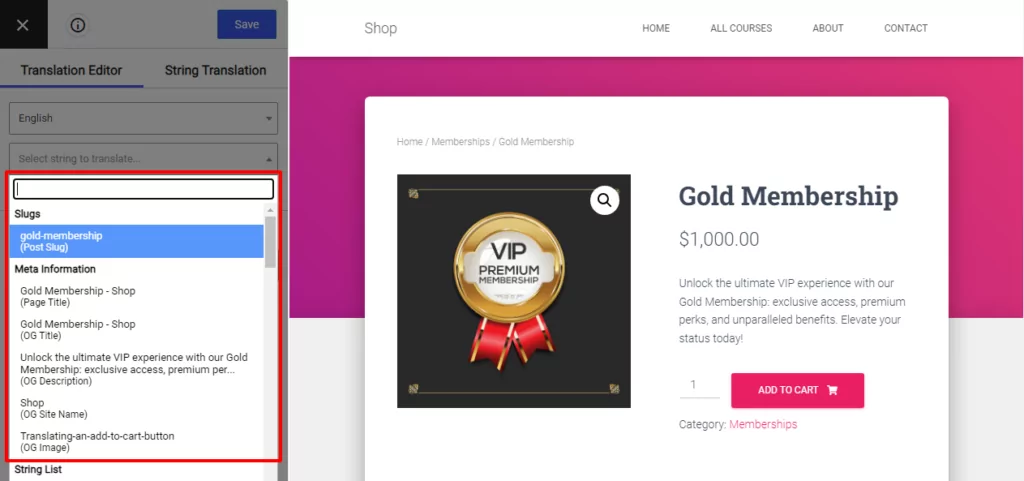
If you’re looking to translate all your URL slugs from one place, you can use the URL Slug Translation interface. This makes it really easy to translate slugs one by one and use the built-in filtering and search options to make sure you don’t leave anything out.
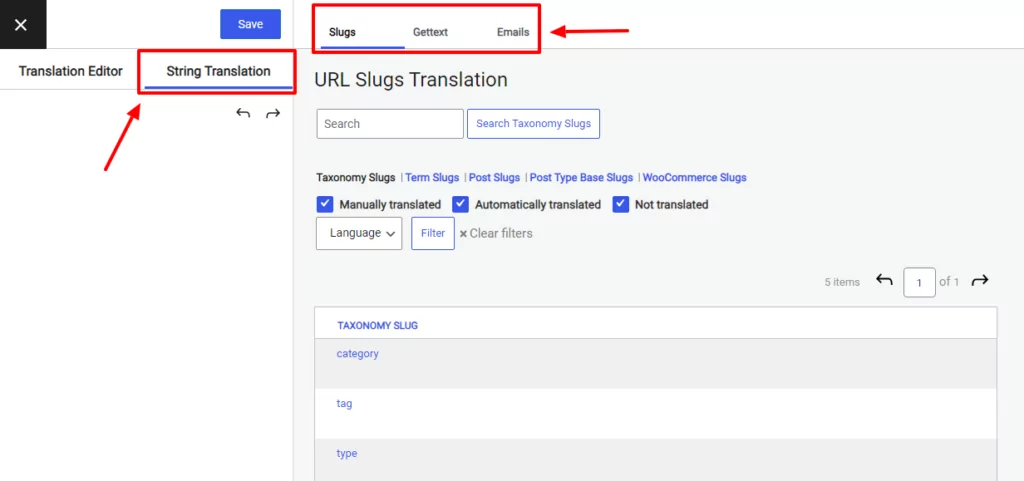
To access it, make sure to switch from the visual translation editor to the String Translation tab. You can also translate WooCommerce emails and gettext strings from the same screen.
4. Add The hreflang Attribute So That Google Knows The Primary Language For Each Piece Of Content
The hreflang attribute is a small code snippet that you can add to the <head> section of your site.
Your human visitors will never see it, but it helps search engines like Google understand the different languages on your site and point searchers to the translation that’s most appropriate for their language.
Let’s make the example more concrete and say you have two versions of the same content. One version is English; the other is German.
The hreflang tag lets Google know which version is which so that Google can serve the English version to English searchers and the German version to German searchers (Google will try to do this by itself, but the hreflang tag makes sure Google gets it right).
Here’s an example of what the hreflang actually looks like behind the scenes:
<link rel=”alternate” hreflang=”en-US” ref=”https://example.com”/>
<link rel=”alternate” hreflang=”de-DE” href=”https://example.com/de/”/>
Where hreflang gets really helpful is when you have different variants of the same language.
For example, maybe you have one page for Spanish speakers from Spain and another for Spanish speakers from Mexico. The hreflang attribute would ensure that searchers from different countries get the proper localized Spanish version.
The hreflang attribute also ensures Google doesn’t think you’ve got duplicate content. If you publish very similar content on your website across multiple pages, Google might get confused about which pages to show in SERPs. This could result in duplicate pages competing with each other, in turn negatively affecting the individual rankings of those pages.
You can avoid this kind of problem by using the hreflang attribute.
If you’re using WordPress, the TranslatePress plugin will automatically add the hreflang attribute for each language that your site uses.
5. Create A Multilingual XML Sitemap
An XML sitemap is basically a “map” of all the content on your site. It helps Google find all your content and is just generally a good basic SEO principle.
For a single-language site, creating an XML sitemap is pretty straightforward. In fact, most SEO plugins will automatically create a sitemap for you without you having to lift a finger.
However, things get a little bit trickier when you have a multi language website because each piece of content is available in different languages at different URLs. Furthermore, Google actually has a specific format that they want you to use in your multilingual sitemap.
In order to properly include each translation in your sitemap, you:
- Use a <loc> element to define a single URL
- Create child <xhtml:link> entries for each language version of the page
If you’re struggling to wrap your head around it, I have good news:
TranslatePress’ SEO Pack add-on integrates with popular SEO plugins (like Yoast, Rank Math, SEOPress, etc.) and extends their sitemap functionality to help you automatically implement a multilingual sitemap that follows Google’s recommendations.
6. Don’t Use 100% Automatic Translation if You’re Serious About SEO
Ok, this one isn’t a hard-and-fast rule, and we’re certainly not trying to say that automatic translation is always bad.
However, if you do opt to use automatic translations for part of your site, Google recommends that you use your site’s robots.txt file to block search engines from crawling the automatically translated content.
Why? Well, here’s Google’s reasoning from that same article—”Automated translations don’t always make sense and could be viewed as spam.”
So, for the content that you want to rank well, it’s worth spending some time to at least manually review any automatic translations that you use.
TranslatePress makes it really easy to edit any content that has been automatically translated (via the built-in Google Translate or DeepL integrations). You can use the visual translation editor to manually refine the translations or set up translator accounts for native speakers to review them.
The same can be said about TranslatePress AI, even if the translation accuracy is higher due to leveraging a combination of top-tier neural machine translation systems, it doesn’t mean that the translated form is actually how people use it to search the web. It’s still better than not having the string translated at all, but keyword research is still paramount, as the right translation could help you rank higher.
7. Make Sure You Can Configure Titles and Meta Information For Each Language
Your content’s title and meta description are what normally shows up in Google’s organic search results.
It’s important to write a quality title and meta description to boost your organic clickthrough rate. And you also usually want to work your focus keyword into the title if at all possible.
On WordPress, you’ll use a WordPress SEO plugin like Yoast SEO to control this information for each page.
However, if the translation plugin that you choose doesn’t let you translate the title and meta description for each language, you’re going to miss out on the SEO benefits for the translated versions of your content.
So—make sure that you pick a translation plugin that will let you translate SEO metadata and other plugin data (which TranslatePress does).
8. Use the International Targeting Report in Google Search Console
Google Search Console is an important SEO tool that lets you view Google Analytics and manage how your site appears in Google search.
Beyond lots of helpful tools for general SEO, it also includes a special International Targeting report tool which helps you with WordPress multilingual SEO. Specifically, it helps you monitor the hreflang tags on your site and find any errors:
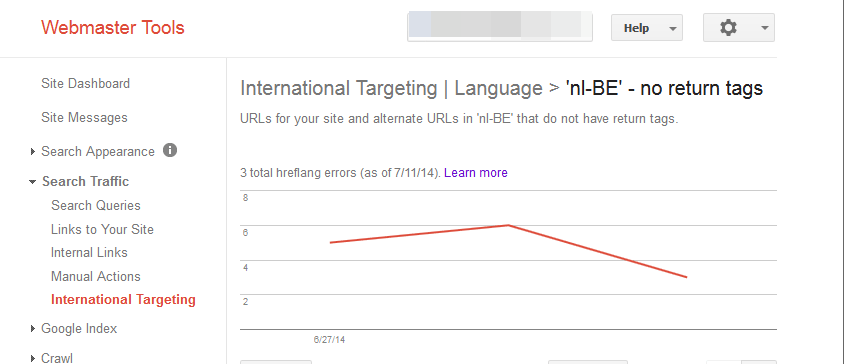
If your site has a generic top-level domain (e.g. .com, .org. or .net, you can use the International Targeting report tool to specify your site’s target locale, but this feature is only useful if you want to target one country. For example, it would make sense to set the target to Canada for a site about restaurants in Montreal; it would not make sense to set the target as Canada if it also targets French speakers in France, Canada, and Mali.
Learn more in Google’s guide to International Targeting. Or, if you’ve already added your site to Google Search Console, you can head straight to your International Targeting report.
Improve Your WordPress Site’s Multilingual SEO Today!
TranslatePress and its SEO Pack add-on are built with all of these WordPress multilingual SEO best practices in mind.
It will help you create a fully indexable site for each translation, along with:
- Translatable URL slugs, SEO metadata, image alt tags, social metadata, etc.
- Proper hreflang usage
- A multilingual XML sitemap (supports popular SEO plugins like Yoast SEO, Rank Math, SEOPresss, etc.).
- Both automatic and manual translation options
To learn more about how TranslatePress can help you create a multilingual WordPress site (or WooCommerce store), check out all of the features.
TranslatePress Multilingual
Do you still have more questions about multilingual SEO? Let us know in the comments!
If you found this post helpful, please check out our YouTube channel, where we constantly upload short & easy-to-follow video tutorials. You can also follow us on Facebook and Twitter to be the first to know each time we post.
Related: 10 Steps to Increase Your Multilingual Site Speed in WordPress
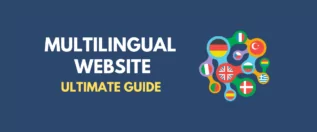


i use subdirectories for each language. best options.